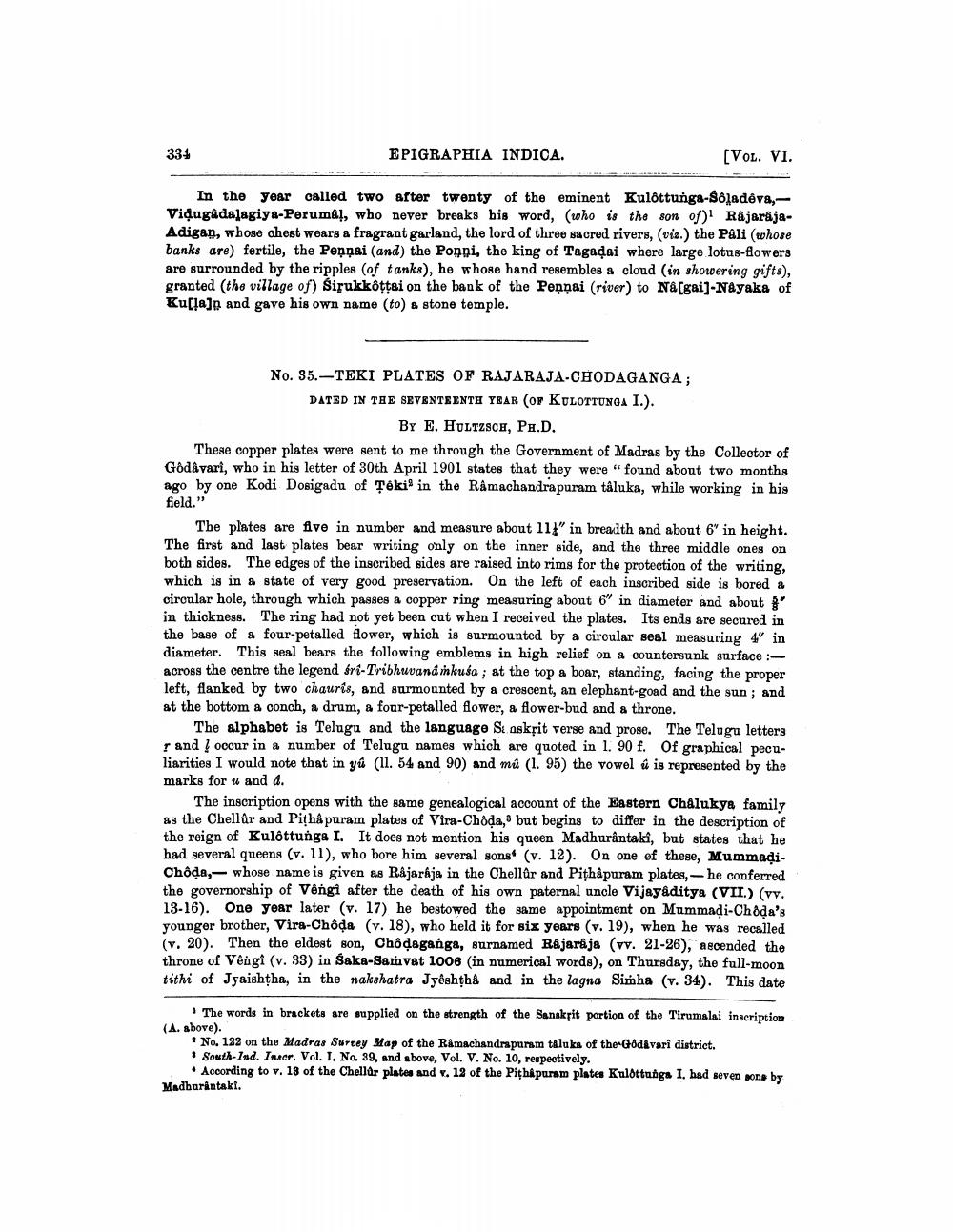________________
334
EPIGRAPHIA INDICA.
(VOL. VI.
In the year called two after twenty of the eminent Kulottunga-Sóladêva,Vidugadalagiya-Peruma!, who never breaks his word, (who is the son of RajarajaAdigan, whose chest wears a fragrant garland, the lord of three sacred rivers, (vis.) the Pâli (those banks are) fertile, the Peņņai (and) the Poppi, the king of Tagadai where large lotus-flowers are surrounded by the ripples (of tanks), he whose hand resembles & cloud (in showering gifts), granted (the village of) Sirukkottai on the bank of the Peņņai (river) to Na[gai)-Nayaka of Ku[la]n and gave his own name (to) a stone temple.
No. 35.-TEKI PLATES OF RAJARAJA-CHODAGANGA; DATED IN THE SEVENTEENTH YEAR (OY KULOTTUNGA I.).
BY E. HULTZSCE, PA.D. These copper plates were sent to me through the Government of Madras by the Collector of Godavari, who in his letter of 30th April 1901 states that they were found about two months ago by one Kodi Dosigadu of Téki in the Ramachandrapuram tâluka, while working in his field."
The plates are five in number and measure about 11" in breadth and about 6' in height. The first and last plates bear writing only on the inner side, and the three middle ones on both sides. The edges of the inscribed sides are raised into rims for the protection of the writing, which is in a state of very good preservation. On the left of each inscribed side is bored a circular hole, through which passes a copper ring measuring about 6" in diameter and about f' in thickness. The ring had not yet been cut when I received the plates. Its ends are secured in the base of a four-petalled flower, which is surmounted by a circular seal measuring 4" in diameter. This seal bears the following emblems in high relief on a countersunk surface :across the centre the legend śri-Tribhwana mkusa ; at the top a boar, standing, facing the proper left, flanked by two chaurís, and surmounted by a crescent, an elephant-goad and the sun; and at the bottom a conch, a drum, a four-petalled flower, a flower bud and a throne.
The alphabet is Telugu and the language Si askrit verse and prose. The Telugu letters rand occur in a number of Telugu names which are quoted in 1. 90 f. Of graphical peculiarities I would note that in yú (11. 54 and 90) and mú (1. 95) the vowel ú is represented by the marks for u and a.
The inscription opens with the same genealogical account of the Eastern Chalukya family as the Chellûr and Pithapuram plates of Vira-Choda, but begins to differ in the description of the reign of Kulôttunga I. It does not mention his queen Madhurântaki, but states that he had several queens (v. 11), who bore him several sonst (v. 12). On one of these, MummadiChôda,- whose name is given as Rajarkja in the Chelldr and Pithapuram plates, - he conferred the governorship of Vengi after the death of his own paternal uncle Vijayaditya (VII.) (vv. 13-16). One year later (v. 17) he bestowed the same appointment on Mummadi-Choda's younger brother, Vira-Choda (v. 18), who held it for six years (v. 19), when he was recalled (v. 20). Then the eldest son, Chôdaganga, surnamed R&jarâja (vv. 21-26), ascended the throne of Vêngi (v. 33) in Šaka-Samvat 1008 (in numerical words), on Thursday, the full-moon tithi of Jyaishţha, in the nakshatra Jyêshtha and in the lagna Sinha (v. 34). This date
1 The words in brackets are supplied on the strength of the Sanskrit portion of the Tirumalai inscription (A. above).
* No. 122 on the Madras Survey Map of the Ramachandrapuram taluks of the Godavari district.
South-Ind. Inger. Vol. I. No. 39, and above, Vol. V. No. 10, respectively.
• According to v. 18 of the Chellår plates and 12 of the Pithapuram plates Kulottunga I. had seven song by Madhurintakt.




